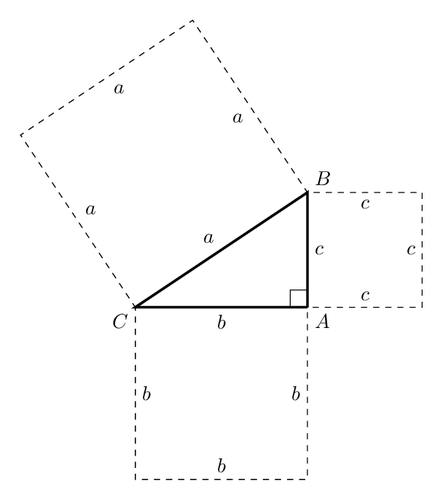We would like to to draw the squares of the sides of a Pythagorean triangle.
The width and height of the triangle are put into constants, so we can change them later if we need to. Loading them once and computing everything else on the fly, it makes it easier to change things around later
We label our coordinates so that the name matches the label which gets printed, otherwise we might get horribly confused.
Two of the rectangles (the ones matching the horizontal and vertical edges) are easy to draw. The square corresponding to the hypotenuse is a bit more difficult, but we can use a little plane geometry. We can find another edge of the square by rotating the original triangle through 90 degrees, and then translating appropriately. We can use the same method to find the two extra coordinates of the hypotenuse square in TikZ.
This example was written by Alex Chan (http://tex.stackexchange.com/users/9668/alexwlchan) answering a question on TeX.SE (http://tex.stackexchange.com/q/166958/213).

Edit and compile if you like:
\documentclass[tikz,border=10pt]{standalone}
\begin{document}
\newcommand{\pythagwidth}{3cm}
\newcommand{\pythagheight}{2cm}
\begin{tikzpicture}
\coordinate [label={below right:$A$}] (A) at (0, 0);
\coordinate [label={above right:$B$}] (B) at (0, \pythagheight);
\coordinate [label={below left:$C$}] (C) at (-\pythagwidth, 0);
\coordinate (D1) at (-\pythagheight, \pythagheight + \pythagwidth);
\coordinate (D2) at (-\pythagheight - \pythagwidth, \pythagwidth);
\draw [very thick] (A) -- (C) -- (B) -- (A);
\newcommand{\ranglesize}{0.3cm}
\draw (A) -- ++ (0, \ranglesize) -- ++ (-\ranglesize, 0) -- ++ (0, -\ranglesize);
\draw [dashed] (A) -- node [below] {$b$} ++ (-\pythagwidth, 0)
-- node [right] {$b$} ++ (0, -\pythagwidth)
-- node [above] {$b$} ++ (\pythagwidth, 0)
-- node [left] {$b$} ++ (0, \pythagwidth);
\draw [dashed] (A) -- node [right] {$c$} ++ (0, \pythagheight)
-- node [below] {$c$} ++ (\pythagheight, 0)
-- node [left] {$c$} ++ (0, -\pythagheight)
-- node [above] {$c$} ++ (-\pythagheight, 0);
\draw [dashed] (C) -- node [above left] {$a$} (B)
-- node [below left] {$a$} (D1)
-- node [below right] {$a$} (D2)
-- node [above right] {$a$} (C);
\end{tikzpicture}
\end{document}
Click to download: pythagoras-triangle.tex • pythagoras-triangle.pdf
Open in Overleaf: pythagoras-triangle.tex


